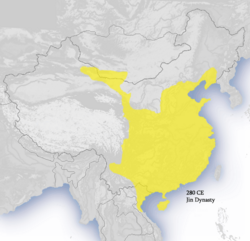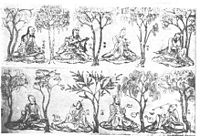Jin Dynasty (265–420)
|
|||||||||||||||||||||||||||||
The Jìn Dynasty (simplified Chinese: 晋朝; traditional Chinese: 晉朝; pinyin: Jìn Cháo; Wade-Giles: Chin⁴-ch'ao²; 265–420), one of the Six Dynasties, followed the Three Kingdoms period and preceded the Southern and Northern Dynasties in China. The dynasty was founded by the Sima family (司馬 pinyin: Sīmǎ). Note that there are four periods of Chinese history using the name "Jin" (see clarification here). At its height the Jin Dynasty had a population of about 20 million people.
Contents |
History
The first of the two periods, the Western Jìn Dynasty (ch: 西晉, 265–316), was founded by Emperor Wu, better known as Sima Yan. Although providing a brief period of unity after conquering the state of Eastern Wu in 280, the Jìn could not contain the invasion and uprising of nomadic peoples after the devastating War of the Eight Princes. The capital was Luoyang until 311 when Emperor Huai was captured by the forces of Han Zhao. Successive reign of Emperor Min lasted four years in Chang'an until its conquest by Han Zhao in 316.
Meanwhile remnants of the Jìn court fled from the north to the south and reestablished the Jìn court at Jiankang, south-east of Luoyang and Chang'an and near modern-day Nanjing, under Prince of Longya. Prominent local families of Zhu, Gan, Lu, Gu and Zhou supported the proclamation of Prince of Langye as Emperor Yuan of the Eastern Jìn Dynasty (ch: 東晉 317–420) when the news of the fall of Chang'an reached the south. (Because the emperors of the Eastern Jìn Dynasty came from the Langye line, the rival Wu Hu states which did not recognize its legitimacy would at times refer to Jìn as "Langye.")
Militaristic authorities and crises plagued the Eastern Jìn court throughout its 104 years of existence. It survived the rebellions of Wang Dun and Su Jun. Huan Wen died in 373 before he could usurp the throne (which he had intended to do). Battle of Fei turned out to be a victory of Jìn under a short-lived cooperation of Huan Chong, brother of Huan Wen and the Prime Minister (or Imperial Secretariat) Xie An. Huan Xuan, son of Huan Wen, usurped and changed the name of the dynasty to Chu. He was toppled by Liu Yu, who ordered the strangulation of the reinstated but retarded Emperor An. The last emperor and brother of Emperor An, Emperor Gong, was installed in 419. Abdication of Emperor Gong in 420 in favor of Liu Yu, then Emperor Wu, ushered in the Liu Song Dynasty and the Southern Dynasties.
Meanwhile North China was ruled by the Sixteen Kingdoms, many of which were founded by the Wu Hu, the non-Han Chinese ethnicities. The conquest of the Northern Liang by the Northern Wei Dynasty in 439 ushered in the Northern Dynasties.
Figure
- Sima's family tree of the 'Western Jìn dynasty'
Sovereigns of Jìn Dynasty
 |
|||||||
|---|---|---|---|---|---|---|---|
| ANCIENT | |||||||
| 3 Sovereigns and 5 Emperors | |||||||
| Xia Dynasty 2100–1600 BC | |||||||
| Shang Dynasty 1600–1046 BC | |||||||
| Zhou Dynasty 1122–256 BC | |||||||
| Western Zhou | |||||||
| Eastern Zhou | |||||||
| Spring and Autumn Period | |||||||
| Warring States Period | |||||||
| IMPERIAL | |||||||
| Qin Dynasty 221 BC–206 BC | |||||||
| Han Dynasty 206 BC–220 AD | |||||||
| Western Han | |||||||
| Xin Dynasty | |||||||
| Eastern Han | |||||||
| Three Kingdoms 220–280 | |||||||
| Wei, Shu & Wu | |||||||
| Jin Dynasty 265–420 | |||||||
| Western Jin | 16 Kingdoms 304–439 | ||||||
| Eastern Jin | |||||||
| Southern & Northern Dynasties 420–589 | |||||||
| Sui Dynasty 581–618 | |||||||
| Tang Dynasty 618–907 | |||||||
| ( Second Zhou 690–705 ) | |||||||
| 5 Dynasties & 10 Kingdoms 907–960 |
Liao Dynasty 907–1125 |
||||||
| Song Dynasty 960–1279 |
|||||||
| Northern Song | W. Xia | ||||||
| Southern Song | Jin | ||||||
| Yuan Dynasty 1271–1368 | |||||||
| Ming Dynasty 1368–1644 | |||||||
| Qing Dynasty 1644–1911 | |||||||
| MODERN | |||||||
| Republic of China 1912–1949 | |||||||
| People's Republic of China (Mainland China) 1949–present |
Republic of China |
||||||
|
Related Articles
|
|||||||
| Posthumous names | Family name and given names | Durations of reigns | Era names and their according range of years |
|---|---|---|---|
| Chinese convention: "Jìn" + posthumous name + "di" | |||
| Western Jìn Dynasty 265–316 | |||
| Wu Di | Sima Yan | 265–290 |
|
| Hui Di | Sima Zhong | 290–307 |
|
| none | Sima Lun | 301 |
|
| Huai Di | Sima Chi | 307 – 311 |
|
| Min Di | Sima Ye | 313–316 |
|
| Eastern Jìn Dynasty 317–420 | |||
| Yuan Di | Sima Rui | 317–323 |
|
| Ming Di | Sima Shao | 323–325 |
|
| Cheng Di | Sima Yan | 325–342 |
|
| Kang Di | Sima Yue | 342–344 |
|
| Mu Di | Sima Dan | 344–361 |
|
| Ai Di | Sima Pi | 361–365 |
|
| Fei Di | Sima Yi | 365–372 | *Taihe 365–372 |
| Jianwen Di | Sima Yu | 372 |
|
| Xiaowu Di | Sima Yao | 372–396 |
|
| An Di | Sima Dezong | 396–419 |
|
| Gong Di | Sima Dewen | 419–420 |
|
Major events
- War of the Eight Princes
- Wu Hu ravaging
- Battle of Fei
- Butterfly Lovers
See also
- Six dynasties
- Sixteen Kingdoms
- Chinese sovereign
- List of tributaries of Imperial China
- Liu Song Dynasty
- Southern Dynasties
- Northern Wei Dynasty
- Northern Dynasties
- Romance of the Three Kingdoms
- Ge Hong
External links
| Preceded by Three Kingdoms |
Dynasties in Chinese history 265–420 |
Succeeded by Southern and Northern Dynasties |

